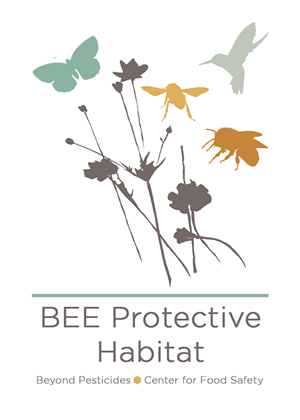BEE Protective
Protecting Honey Bees and Wild Pollinators From Pesticides
Beyond Pesticides advocates for widespread adoption of organic management practices as key to protecting pollinators and the environment, and has long sought a broad-scale marketplace transition to organic practices that legally prohibits the use of toxic synthetic pesticides, and encourages a systems-based approach that is protective of health and the environment. Learn more (below) on the role that pesticides play in pollinator decline, and actions you can take to BEE Protective. For information on growing plants to protect pollinators, see our Pollinator-Friendly Seeds and Nursery Directory. Use the Bee Protective Habitat Guide to plant a pollinator garden suited for your region, and consider seeding white clover into your lawn; learn more from Taking a Stand on Clover.
For an overview, watch our short-film, Seeds that Poison, below. The video highlights the hazards associated with a major use of bee-toxic pesticides — seed coatings — and puts the problem in the broader context of environmental contamination, while suggesting a course for change. Please use the video in conjunction with the resources cited below.
| Quick Links |
|
|
Background
Since 2006, honey bees and other pollinators, in the U.S. and world-wide,
have experienced ongoing and rapid population declines. This continuing
crisis threatens the stability of ecosystems, economies, and the food
supply: one in three bites of food is dependent on pollinator services.
In 2013, Beyond Pesticides joined with beekeepers and environmental allies in a lawsuit challenging EPA's approval of two neonicotinoid pesticides. These highly toxic, persistent, and systemic chemicals have been widely implicated as leading factors in pollinator declines. For a primer on the pollinator crisis, see the lawsuit's Press Release. Also, read the 2013 Lawsuit, Appendix A: Clothianidin, and Appendix B: Thiamethoxam.
Follow the links below for more in-depth information on this important issue, and view Beyond Pesticides' latest pollinator-related Daily News Blog articles (right).
BEE Protective
In order to move action forward on the pollinator crisis, Beyond Pesticides and The Center for Food Safety launched the BEE Protective campaign, a national public education effort that supports local actions to protect honey bees and other pollinators from pesticides and contaminated landscapes.
BEE Protective includes a variety of educational materials to help encourage municipalities, campuses, and individual homeowners to adopt policies and practices that protect bees and other pollinators from harmful pesticide applications, and create pesticide-free refuges for these beneficial organisms. In addition to scientific and regulatory information, BEE Protective also includes a model community pollinator resolution and a pollinator protection pledge. Pollinators are a vital part of our environment and a barometer for healthy ecosystems. Let's all do our part to BEE Protective of these critical species.
|
Resources and Educational Materials: Make use of the resources below as you advocate to BEE Protective! Feel free to make copies and hand them out in your community! |
|
|
|
|
|
|
|
|
|
|
|
|
|
 BEE Protective in Your Community
BEE Protective in Your Community
You can make your town or school or college campus pollinator friendly by working to curtail or eliminate the sale and/or use of bee-harming neonicotinoid pesticides.
- Build the buzz in your community to make changes that will protect your local pollinator population. Get the Model Community Pollinator Resolution in the hands of local elected officials, school administrators, businesses, or municipal administrators.
- Display a Pesticide-Free Zone sign for your yard, and show your neighbors that pesticide-free spaces are important for health and the environment.
- When gathering support, keep in mind these important tips on grassroots organizing.
- Consider going door to door with a petition to get your message across, or start one online though websites such as change.org.
- Recall sucesses in other communities for inspiration and encouragement. Consider the achievements of Eugene, OR, Spokane, WA, and Shorewood, MN, as well as the "Bee-Safe" communities in Boulder, CO that got more than 150 contiguous homes to pledge to stop using bee-harming pesticides.
- Need some additional pointers, or already had sucess getting your community or campus to go pesticide free? Contact the BEE Protective campaign at [email protected] or 1.202.543.5450 and let us know!
Pollinator Alerts
Help Beyond Pesticides grow the pressure on all fronts by asking retailers, administrators, and elected officials to take action to eliminate or curtail the sale and use of neonicotinoid pesticides.
- Help us build a network of safe spaces for pollinators across the country. Sign the Pollinator Pledge declaring your property as pesticide free, organic, and pollinator friendly.
- Tell Your Member of Congress to Support the Saving America's Pollinators Act. Capitol Hill is buzzing about a new bill that aims to provide long overdue protections for America's imperild pollinators.
- Bees can't wait 5 more years. And neither can we. Join our campaign to ban bee-harmful neonicotinoid pesticides.
- Tell Retailers to Stop Selling "Pre-Poisoned" Plants. Beyond Pesticides helped to release a new first-of-its-kind report, with Friends of the Earth and other allies, which reveals that the world’s most popular pesticides, neonicotinoids (neonics), are implicated as a key factor in global bee die-offs, and may be lurking in our own gardens.
Back to top










